The rail runs through it
August 31, 2009 by admin
Filed under Related Interests
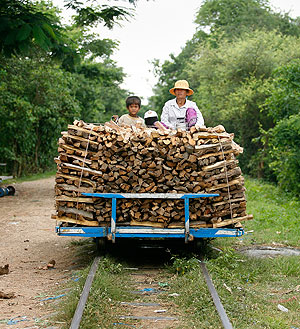
The bamboo rail transporting firewood in Cambodia. -- CAROLINE CHIA/THE STRAITS TIMES
AS THE train pulls away from Tanjong Pagar, factories loom like skyscrapers and squat houses acquire an imposing air. Familiar sights turn foreign even before we cross the border. Our journey across five countries has just begun. Inside the chilly carriages of KTM’s Ekspres Rakyat to Butterworth, Mr Bean stumbles his way through gaffes on the Samsung flatscreen television as a family tucks into a breakfast of bread and apricot jam. Other passengers catch a nap on plush fabric seats before we hit the checkpoint at Woodlands. It will be the first of four borders we pass in our bid to travel 5,000km to the edge of China via the route of the Singapore-Kunming Rail Link project.

Students run to catch a train as it pulls up of Bangkok's Hualamphong Train Station. -- CAROLINE CHIA/THE STRAITS TIMES
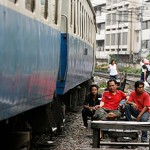
Some tables placed on the island of loose pebble between two railway tracks act as a gathering place for Bangkok folk living near the railway station. -- CAROLINE CHIA/THE STRAITS TIMES
A 13-year-old initiative of the Association of South-east Asian Nations (Asean), the proposed rail network spans more than 5,000km across Malaysia, Thailand, Cambodia, Vietnam and China, and includes spur lines to Laos and a Vietnam port along one route. We take 15 hours to reach the northern Malaysian town of Butterworth, before hopping onto the 20-hour Ekspres Antarabangsa sleeper train that cuts through the jungles of southern Thailand. In a region where airports and shipping are an extension of national ego, the rail route gives us an unvarnished backyard glimpse of each

A station staff takes a nap at Bangkok's Hualamphong Train Station. -- CAROLINE CHIA/THE STRAITS TIMES
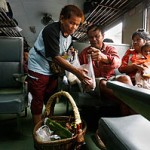
Ms Phai, a food vendor, selling fermented mince pork to passengers on a train before it pulls out of the station. -- CAROLINE CHIA/THE STRAITS TIMES
destination. At the Thai-Malaysian checkpoint in Padang Besar, a lopsided sign posts a lingering reminder of Thailand’s more austere past: Aliens with a ‘hippy characteristic’ it warns, will be deported. The order is dated 1979. Many of our fellow passengers are regulars on this cross-country route. Malaysian Leong Geok Lin, 44, for example, spends most of her time working with Thai orphans and survives on a RM400 (S$168) monthly allowance. The train, she says, is the cheapest way for her to travel between the two countries. Two days
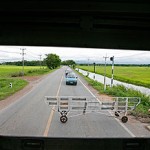
Looking out from our train window as we travelled from Bangkok to Aranyaprathet. -- CAROLINE CHIA/THE STRAITS TIMES

The former Poipet Railway Station in Cambodia is houses many families who moved in after trains services there were destroyed. -- CAROLINE CHIA/THE STRAITS TIMES
later, on our third-class-only service 275 from Bangkok to the Cambodian border, the train fills up with villagers laden with fresh produce and Cambodian workers heading home. The migrant workers crowd around the rear wagons. Ms Sieb Saisieb, 38, is heading home for the yearly visit she has been making ever since she started work in a Bangkok plastic bag factory. She says: ‘Five years ago, I was a farmer in Sisophon town but I earned just enough to survive. In Bangkok, I can make 184 baht (about S$7) a day with overtime. ‘Find me a job,’ she implores, half in jest. ‘I want to go to
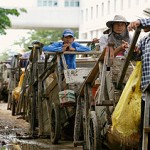
Cambodians with their carts wait in line to cross the border between Thailand and Cambodia at Poipet. -- CAROLINE CHIA/THE STRAITS TIMES
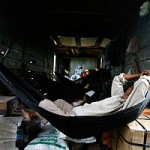
Chief of Train, Mr Kong Thom,55, takes a nap amidst boxes of milk powder and ketchup on the freight train as it travels from Sisophon to Phnom Penh. -- CAROLINE CHIA/THE STRAITS TIMES
Singapore.’ She gets off, like us, at the Thai border town of Aranyaprathet because the trains go no further from here.
Poipet
THAILAND’S tracks are not connected to Cambodia’s rail network, which lies in shambles after decades of war and inadequate funding. The country is the main missing link in the Singapore to Kunming railway network. It has about 600km of single meter-gauge track running from the inland town of Sisophon to its port of Sihanoukville via its capital, Phnom Penh.
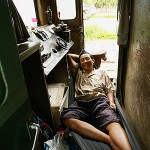
Mr Leng Savath, 56, the freight train driver in Cambodia. He sometimes gets to drive the train only once a month. -- CAROLINE CHIA/THE STRAITS TIMES
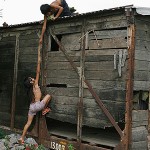
Children at an abandoned train carriage that is now houses a 3 generation family. -- CAROLINE CHIA/THE STRAITS TIMES
There is only one passenger train service in Cambodia. It runs once a week, crossing some 270km from Phnom Penh to Battambang town on Saturdays and returns to the capital on Sundays. The trip takes 13 hours or more, about three times longer than by bus. Just over 900 people took that train each week in 2005. These days, the figure is probably closer to 120, reckons train driver Leng Savath. Catching that train entails entering Cambodia via Poipet, a town linked to Thailand by rail until the tracks were destroyed about 50 years ago. It is Cambodia’s busiest land border crossing with Thailand now, though the

Chan Sreynoch, 23, with her husband Touh Sopheak, 24, and son, Khon Bopha, 7 months, in their home- an abandoned wooden train carriage. -- CAROLINE CHIA/THE STRAITS TIMES

Cambodians taking the bamboo rail from one village to another. The bamboo 'train' plys along a stretch of 30km. -- CAROLINE CHIA/THE STRAITS TIMES
constant traffic presents both promise and peril. Trafficking syndicates send indentured children to beg across the border, while the influx of child sex tourists is apparent in posters pleading: ‘Please respect our children. Do not harm or sexually exploit our children.’ Still, there is money to be made, whichever way you see it. Poipet’s smoky, neon-lit casinos bustle with day-trippers from Thailand camped around its baccarat tables with bottles of Singha beer. Just metres away outside, Cambodian barefoot porters pull wooden carts towards Thailand, where they will load up and lug back durians and mangoes, for 120 baht to 130 baht a day. Among them is a 60-year-old
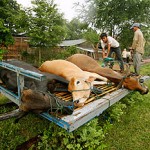
Cows are being transported by the bamboo rail to Battambang market to be slaughtered. -- CAROLINE CHIA/THE STRAITS TIMES

The interior of a passenger train in Cambodia. The country has only one passenger trains service that travels between Phnom Penh and Battambang. -- CAROLINE CHIA/THE STRAITS TIMES
woman who has tucked her eight-month-old grandchild into her cart for company. ‘Sometimes I carry her, sometimes I put her in the cart,’ she says, giving the child a pod of tamarind to suck on.
Battambang
ABOUT 100km from Poipet lies Battambang town, which boasts of outskirts served by one of the most reliable ‘railways’ in the country. These consist of dozens of bamboo rafts powered by portable motors running on underused rail tracks improvised by the locals. A 30km ride on the ‘bamboo train’ costs locals 5,000 riel (S$1.70). It
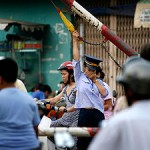
A train officer closes the gantry at a Hanoi train crossing as motorbikes whizz around her. -- CAROLINE CHIA/THE STRAITS TIMES
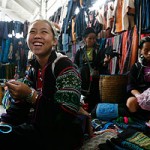
Giang Thi Mao, 14, holds on to one end of a friendship band as it is being pleated. Mao, from the Black Hmong tribe, spends her summer holidays with friends and foreigners visiting Sapa. -- CAROLINE CHIA/THE STRAITS TIMES
leaves only if there are 10 people on board, or if the driver decides he is done waiting. At Ou Dambang commune, a 10- minute drive from Battambang, we haggle with 24-year-old driver Sorn Thin, settle on a tourist price of US$15 (S$21), then hop onto the strips of bamboo nailed together to form the platform. No handrails are in sight as we hurtle through the Cambodian countryside at 40km per hour, lurching each time its wheels hit the misaligned track. These ‘trains’ transport everything from fuel and fertiliser to livestock to communities hard to access by road. Since dozens of bamboo trains zip about on one single track on any given day, there’s a lot of give and take to make sure everybody gets to where they are headed in good time. Heft,

(Left - Right) Ly Thi Chau, 13, Ly Thi Zao, 11, Giang Thi Mao,14, and Giang Thi Chan,12, from the Black Hmong tribe in Sapa, spend most of their day along the streets speaking to foreigners. -- CAROLINE CHIA/THE STRAITS TIMES
ironically, gets us to our destination faster because lighter ‘trains’ – by community consensus – have to be dismantled to let us pass. But these lightning-quick calculations of who should give way are thrown out of the window when a real train suddenly chugs by. The lumbering giant loaded with logs causes a suspension of bamboo train services but presents an opportunity for extra income. Out of nowhere, hordes of young men, women and children rush forward to haul the wood to the side of the tracks. A businesswoman haggles with an armed policeman guarding the wood, then hands over a stack of riel. An hour later, the train is almost emptied of wood, and continues on its bereft way to Battambang station. The grinning porters pocket 10,000 riel each and promptly spend it on pong tea khon (fertilised duck eggs) at a roadside stall.
The train to Phnom Penh
IT IS not exactly news when the passenger train due to travel from Battambang to Phnom Penh doesn’t show up. It has broken down – again. We hitch a ride instead on a cargo train. It grinds along at a glacial speed of 10kmh on a track partially smothered under weeds. Beat-up motorcycles and buses zoom past us on a parallel highway. In a dark wagon filled with boxes of Thai ketchup, milk powder and claw hammers, railway employees and businessmen swing languidly in hammocks they have brought along and strung across the carriage. These small proprietors, says train supervisor Kong Thom, have to travel with their goods to ‘guarantee their safe arrival’. The trains run so irregularly that our driver Leng Savath, 56, sometimes gets behind the wheel just once a month. Mr Kong Thom says: ‘Most people working on the trains have other jobs. I help my wife to run her grocery shop in Phnom Penh. I do this trip only two to three times a month.’ The salaries are correspondingly low. Train guard Teuk Sophal, 46, earns 67,000 riel a month, and can only afford to live in an abandoned railway carriage by Phnom Penh train station. Two hours into the journey, the train grinds to a halt. Engine problems. We get off with the staff for fresh air, while the driver does repairs. Half an hour later, we resume our crawl to Phnom Penh. After six more hours of wobbling on ketchup box-seats, we get off at Pursat town to seek the comfort of an unmoving bed. The train, we later learn, arrives at Phnom Penh 166km away only in the wee hours of the next morning.

Hmong girls gather outside a restaurant to watch TV in Sapa. -- CAROLINE CHIA/THE STRAITS TIMES
‘The dream has wheels’
LATER, in Phnom Penh, we stumble upon the passenger train that we had meant to take, and realise why it is shunned by all but the poorest of locals. The carriage’s wooden floorboard bears gaping wounds that give a clear view of the tracks beneath. Broken benches unscrewed from the carriage floor are heaped in one corner. Sunlight streams in through a rusting hole in the roof. It may seem dismal now. But Cambodia’s rail network is due for renewal if its government stays the course on one of its latest high-profile projects. The country started work earlier this year to rehabilitate and rebuild 650km of rail track after getting US$55 million in loans from the Asian Development Bank and Organisation of Petroleum Exporting Countries. Malaysia is contributing US$3 million worth of reclaimed rails. The plan is to reconnect Cambodia’s railway to Thailand’s, and, hopefully, provide safer and more comfortable options to the bamboo train. Domestically, the project promises to take freight off the roads, reduce congestion and cut pollution at a time of soaring fuel costs. Regionally, it could give the Singapore to Kunming Rail Link plan – which has sputtered more than once due to its high estimated cost of $3 billion – a shot in the arm. Once Cambodia completes its rail project by 2011, all that would stand between a single uninterrupted rail route from Singapore to Kunming within Asean’s borders would be a missing 400km section between Phnom Penh and Ho Chi Minh City in Vietnam. China, on its part, has already started rebuilding its century-old rail link to north-western Vietnam, which forms the tail end of the route. The regional rail network is crucial in bringing the young economies of Laos, Cambodia and Vietnam up to speed with Asean’s more affluent members and to pave the way for a genuine Asean economic community, says Asean watcher Denis Hew. Mr Barry Cable, director of the transport and tourism division of the United Nations Economic and Social Commission for Asia and the Pacific, says developing the railway sector will diversify development away from coastal areas. It could also mean more. British current affairs magazine Monocle calls rail connections ‘a hopeful sign of stability’ as the existence of regular, scheduled rail services between countries are more powerful symbols of integration than disparate roads or air links. It is a sign that is sorely needed now, as Cambodia and Thailand bicker over the ownership of the 11th-century Preah Vihear temple on their shared border. Crucial motivation to close the rail gap between Vietnam and Cambodia will come from the success of the current Cambodian project. ADB Cambodian director Arjun Goswami says: ‘As a vision, I love the idea of the (regional rail link). If we get the Cambodian project done, we can say the dream has legs, or should I say, wheels.’ Cambodians like security guard Mey Chea, 31, cling to that dream. He says: ‘In the future, our trains will be like the ones in China we see on TV. They will be comfortable, efficient and modern.’

Nguyen Van To, 12, takes a break from shovelling sand as his father steers their boat to the sand collection point along the banks of Perfume River. -- CAROLINE CHIA/THE STRAITS TIMES
The train to Hanoi
ON BOARD the Vietnam’s Reunification Express, which travels the length of the country, Hanoi natives working in the southern financial hub of Ho Chi Minh City return home with gifts of cake and dragon fruit, joining holidaymakers heading north to catch the sights of the limestone karsts of Halong Bay. Youths charge their iPods in the electrical sockets in the toilets, while tan-averse women hunker down for the long ride with sun hats and cloth masks. The 1,726km-long Saigon to Hanoi line, built in the 1930s, was repeatedly bombed and sabotaged during World War II, the Franco-Viet Minh War and the subsequent conflict between the American-backed South and the communist North. It was quickly repaired within one year after the North’s victory to symbolise Vietnamese unity. The service has come a long way since, says retiree Nguyen Ngoc Loat, 70, who is on his way to visit relatives in Hanoi. ‘It used to be very messy in the past. It could take three days to get from Hanoi to Ho Chi Minh City. ‘People would steal things from you when you were sleeping, or they would put fragile things on the edge of their seats, and demand inflated sums if you break the items when you walk past them. It is much safer now.’ Still, there are other things to worry about. As we speed past buffaloes taking a dip in a pond one hour from Hue, the air-conditioner seizes up. The women remove their sodden cloth masks. A train attendant turns up with a hairdryer and spends the next hour trying to thaw out the aircon vent above our heads. It yields – but only briefly. Embarrassed that foreigners should be witnessing such a spectacle, a Vietnamese mutters to us: ‘Excuse me, excuse me.’ But a few hours later, as the carriage fills up with the odour of stale sweat and dinner scraps, he props his feet by my elbow and snores his way to dreamland.
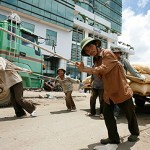
Vietnamese labourers pulling sacks of peanuts to be exported to China towards the Vietnam- China border at Lao Cai, Vietnam. -- CAROLINE CHIA/THE STRAITS TIMES
Lao Cai final stop, for now
I LIE awake on my bunk bed as rain beats on the windows of service SP3 from Hanoi to Lao Cai. In the distance, the clouds hang low over the Hoang Lien mountain range. This route is frequented by tourists heading towards the hill resort of Sapa, which means that it is served by some of the most luxurious sleeper trains in the country. Darkwood interiors, soft lighting, complementary fruit baskets all add up to a one-way ride that can cost US$140. Meanwhile, those who endure the 294km ride on a hard wooden seat pay only 80,000 dong (S$6.80) a ticket. Lao Cai, our fifth border in 17 days, is our final stop. Passenger train services onward to China do not exist as Beijing is rehabilitating its section of the regional link that runs from Kunming to its border town of Hekou. That lies just across the Red River, from Lao Cai. The first section of the work is set to be completed by next year, while work on the remaining section is due to start this year. When that is completed, it will re-establish a rail connection that was built way back in 1910. Meanwhile, the town’s residents bridge the missing links in their own way. Renminbi is readily accepted in the casino at Lao Cai International Hotel. Chinese signs at the jackpot machines plead: ‘Please do not place your cigarette butts on the coin dispenser trays.’ Most of the fruit and vegetables on sale in the local market come from China. Vietnamese salesgirls at the souvenir store at Lao Cai-Biti’s Trade Centre light up when they hear ‘Duo shao qian?’ (‘how much’ in Mandarin). Labourers haul sacks of Vietnamese peanuts and lychee across the bridge linking both sides while Chinese trucks roar by in the other direction. A billboard in Hekou greets visitors entering China with a postcard picture of Vietnam’s Halong Bay. In years to come, the train that passes through here will cut through more than five borders as it wends its way through South-east Asia. By then, perhaps, the borders may cease to matter.
VIDEO CLIPS
(2:24)
embedded by Embedded Video
Download Video
![]()
(2:14)
embedded by Embedded Video
Download Video
SOURCE : http://www.straitstimes.com

















